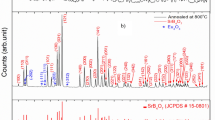Abstract
A series of novel red-emitting phosphors scheelite-like triple molybdates LiKGd2−x Eu x (MoO4)4(0.1 ⩽ x ⩽ 1.9) were synthesized by solid state reaction method and their photoluminescence properties were investigated. The photoluminescence results show that all samples can be excited efficiently by UV (396 nm) light and blue (466 nm) light and emit red (615 nm) light with line spectra, which are coupled well with the characteristic emission from UV-LED and blue LED, respectively. The experimental results and their analysis suggest that the energy transfer occurs due to dipole-dipole interactions among Eu3+ ions in LiKGd2−x Eu x (MoO4)4. Compared with Ca0.8MoO4: Eu 3+0.2 , the emission intensity of LiKGd0.9(MoO4)4: Eu 3+1.1 Eu is about 1.4 times higher and the CIE chromaticity coordinates are as close to the National Television System Committee (NTSC) standard values as those of Ca0.8MoO4: Eu 3+0.2 . The optical properties suggest that LiKGd0.9(MoO4)4: Eu 3+1.1 is an efficient red-emitting phosphor for white LEDs applications.
Similar content being viewed by others
References
Hu Y S, Zhuang W D, Ye H Q, et al. A novel red phosphor for white light emitting diodes. J Alloys Compd, 2005, 390: 226–229
Wang Z L, Liang H B, Zhou L Y, et al. Luminescence of (Li0·333Na0·334K0·333) Eu (MoO4)2 and its application in near UV In-GaN-based light-emitting diode. Chem Phys Lett, 2005, 412: 313–316
Yan S X, Zhang J H, Zhang X, et al. Enhanced red emission in CaMoO4: Bi3+, Eu3+. J Phys Chem C, 2007, 111: 13256–13260
Xie A, Yuan X M, Wang J J, et al. Synthesis and photoluminescence property of red phosphors LiEu1−x Yx(WO4)0.5(MoO4)1.5 for White LED. Sci China Ser E-Tech Sci, 2009, 52: 1913–918
Neeraj S, Kijima N, Cheetham A K. Novel red phosphors for solid-state lighting: The system NaM (WO4)2−x (MoO4)x: Eu3+ (M=Gd, Y, Bi). Chem Phys Lett, 2004, 378: 2–6
Basovich O M, Khaikina E G. Formation laws for scheelite-like triple molybdates LiMLn2(MoO4)4. Russian J Inorg Chem, 2006, 51: 1082–1086
Klevtsova R F, GUnskaya L A, Alekseev V I, et al. Crystal structural study of ternary molybdate LiRbBi2(MoO4)4. Zhumal Struktumoi Khimii, 1994, 34: 152–156
Klevtsova R F, Solodovnikov S F, Glinskaya L A. Synthesis and crystal structure of the binary molybdate Li8Bi2(MoO4)7. J Struct Chem, 1997, 38: 89–95
Mazumdar S. A standardless method of quantitative ceramic analysis using X-ray powder diffraction. J Appl Cryst, 1999, 32: 381–386
Xie A, Yuan X M, Shi Y, et al. Photoluminescence characteristics of energy transfer between Eu3+ and Bi3+ in LiEu1−x Bix(WO4)0.5(MoO4)1.5. J Am Ceram Soc, 2009, 92: 2254–2258
Chiu C H, Wang M F, Lee C S, et al. Structural, spectroscopic and photoluminescence studies of LiEu (WO4)2−x (MoO4)x as a near-UV convertible phosphor. J Solid State Chem, 2007, 180: 619–627
Xie A, Yuan X M, Shi Y, et al. Enhanced red emission in ZnMoO4: Eu3+ by charge compensation. J Phys D: Appl Phys, 2010, 43: 1–6
Rao R P, Devine D J. RE-activated lanthanide phosphate phosphors for PDP applications. J Lumin, 2000, 87–89: 1260–1263
Wang X X, Xian Y L, Shi J X, et al. The potential red emitting Gd2−y Euy (WO4)3−x (MoO4)x phosphors for UV InGaN-based lightemitting diode. Mater Sci Eng B, 2007, 140: 69–72
Kovac J, Peternai L, Lengyel O. Advanced light emitting diodes structures for Op to electronic applications. Thin solid Films, 2003, 433: 22–26
Narendaran N, Gu Y, Freyssinier J P, et al. Solid state lighting: Failure analysis of white LEDs. Cryst Growth, 2004, 268: 449–456
Xie A, Yuan X M, Wang F X, et al. Synthesis and luminescent properties of Eu3+-activated molybdate-based novel red-emitting phosphors for white LEDs. J Alloys Compd, 2010, 501: 124–129
Li X, Yang Z P, Guan L, et al. Luminescent properties of alkali metal ion and trivalent europium ion co-activated alkaline earth molybdate phosphors. J Synth Cryst, 2007, 36: 1192–1196
Chan T S, Kang C C, Liu R S, et al. Combinatorial study of the optimization of Y2O3: Bi, Eu red phosphors. J Comb Chem, 2007, 9: 343–346
He P, Wang H H, Liu S G, et al. An efficient europium(III) organic complex as red phosphor applied in LED. J Electrochem Soc, 2009, 156: E46–E49
Ci Z P, Wang Y H, Zhang J C, et al. Ca1−x Mo1−ySiyO4: Eux 3+: A novel red phosphor for white light emitting diodes. Physica B, 2008, 403: 670–674
Tan Y, Shi C. Ce3+→Eu2+ energy transfer in BaLiF3 phosphor. J Phys Chem Solids, 1999, 60: 1805–1810
Blasse G. Energy transfer in oxidic phosphors. Philips Res Rep, 1969, 24: 131–144
Author information
Authors and Affiliations
Corresponding authors
Rights and permissions
About this article
Cite this article
Xie, A., Yuan, X. & Wang, F. A potential red-emitting phosphors scheelite-like triple molybdates LiKGd2(MoO4)4:Eu3+ for white light emitting diode applications. Sci. China Technol. Sci. 54, 70–75 (2011). https://doi.org/10.1007/s11431-010-4222-y
Received:
Accepted:
Published:
Issue Date:
DOI: https://doi.org/10.1007/s11431-010-4222-y




